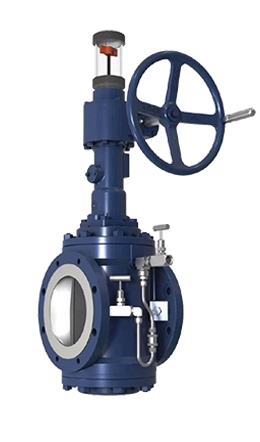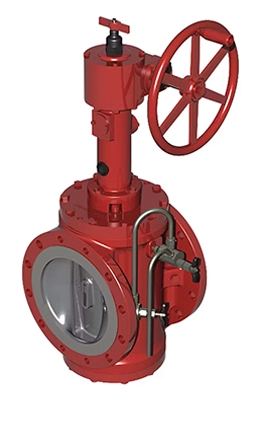KFTE manufactures a comprehensive range of Double Block and Bleed Plug Valve in sizes up to 42" (1050 mm), and in ASME classes from 150 to 600. The valves are offered in a combination of materials and actuation options to suit customer requirements. Double Block and Bleed Plug Valve provides online-verifiable bubble tight sealing and is a safe and reliable replacement to the conventional two-valve system. In this valve, high integrity positive shut-off is obtained mechanically, independent of line pressure, without sealants/ lubricants. Globally, the valve has emerged as the industry standard for movement and storage of petroleum products in refineries, petrochemical plants pipelines, tank farms and terminals.


Double Block and Bleed (DBB) plug valves are critical for ensuring safety and isolation in high-risk environments. Below are the key industries where these valves are prominently used
1. Oil & Gas
Applications include pipelines, refineries, and gas distribution systems. DBB plug valves ensure isolation during maintenance and emergency shutdowns, meeting standards like API 6D and ISO 10423.
2. Chemical & Petrochemical
Used for handling corrosive media, solvents, and hydrocarbons. KFTE's DBB valves are designed for chemical and petroleum industries, offering leak-tight isolation during processes .
3. Power Generation
Thermal power plants and gas turbines rely on DBB plug valves for quick-closing safety mechanisms.
4. Biogas & Landfill Gas
KFTE's DBB plug valves are explicitly designed for biogas and landfill gas systems, ensuring safe control and isolation of gas flows.
5. Pharmaceutical & Paper Manufacturing
KFTE's DBB plug valves are applied in pharmaceutical and paper industries, adhering to strict hygiene and safety standards.
6. Smelting & Metallurgy
High-temperature and high-pressure environments in smelting operations utilize DBB plug valves for reliable isolation.
7. Urban Construction & Infrastructure
Pipeline systems and municipal gas distribution networks employ DBB plug valves for safety and regulatory compliance.
A Double Block and Bleed (DBB) plug valve is engineered to provide two independent seals (blocks) and a bleed port to safely isolate and vent trapped fluids. Below are its key components and their functions:
1. Body
The main housing, typically made of cast steel, stainless steel, or corrosion-resistant alloys.
Designed to withstand high pressure, temperature, and corrosive media.
Contains inlet, outlet, and bleed port connections.
2. Plug
A cylindrical or conical rotating element with a flow passage.
Rotates 90° to open/close flow. In the closed position, it creates two sealing points (double block).
Often coated or hardened for wear resistance (e.g., tungsten carbide).
3. Seats
Two annular sealing surfaces (upper and lower) that interface with the plug.
Provide the primary and secondary blocks to prevent leakage.
Made of resilient materials like PTFE, reinforced elastomers, or metal for high-temperature applications.
4. Stem
Connects the plug to the actuator or handle.
Transmits rotational force to the plug.
Sealed with packing (e.g., graphite) to prevent stem leakage.
5. Actuator
Manual (lever/handwheel), pneumatic, hydraulic, or electric mechanism for valve operation.
Enables quick closure (critical for emergency shutdowns in industries like oil and gas).
6. Bleed/Vent Port
A small valve or port located between the two sealing surfaces.
Allows trapped pressure/fluid between the blocks to be safely drained or sampled.
Ensures zero leakage during maintenance.
7. Seals and Gaskets
Secondary sealing elements (e.g., O-rings, lip seals) to enhance leak-tight performance.
Resistant to chemical degradation and temperature extremes.
8. End Connections
Flanged, threaded, or welded ends for pipeline integration.
Compliant with industry standards (e.g., ASME B16.5 for flanges).
9. Bonnet
Covers the stem and seals the top of the valve body.
Bolted or threaded for easy maintenance access.
10. Lubrication System (Optional)
Some plug valves include grease fittings to inject lubricant between the plug and seats.
Reduces friction and enhances sealing in abrasive or high-pressure applications.
